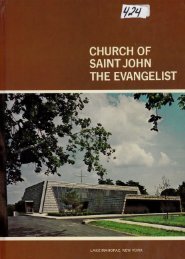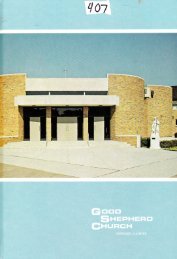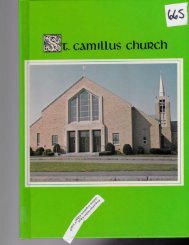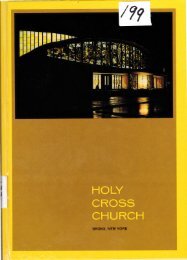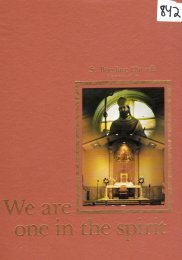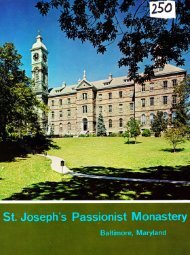Untitled - Digitizing America
Untitled - Digitizing America
Untitled - Digitizing America
Create successful ePaper yourself
Turn your PDF publications into a flip-book with our unique Google optimized e-Paper software.
and 8,811 in 1850. By 1860, there was a total<br />
population of 9,723- including 1,028 slaves.<br />
The beginning of the Civil War in 1861<br />
found citizens of Potosi divided in their sympathies,<br />
and they went on record in May, 1861, in<br />
favor of armed neutrality. In the same month,<br />
however, Federal troops took over Potosi, forcing<br />
citizens to take sides. Some joined the Union<br />
troops, while others helped to form Confederate<br />
companies behind rebel lines.<br />
There were a number of skirmishes and<br />
raids by Southern troops during the war, but it<br />
was in 1864 that Potosians came under a major<br />
attack by General Jo Shelby. A story is told that<br />
the church became a re{uge for women and<br />
children, and that the three-tiered tower was<br />
weakened from the impact of an artillery ball.<br />
During the war years, Father Fox had religious<br />
articles of the church moved to Allen's Cave.<br />
During that time St. James had no resident<br />
pastor. In 1866, Reverend Michael O'Reilly,<br />
who had just been ordained, was appointed to<br />
assist Father Fox at Old Mines. When parishioners<br />
of St. James heard this, they sent a delegation<br />
to Archbishop Kenrick to remind him of<br />
hispromise to send a residentpastor. Mr. Joseph<br />
Connolly had set aside quarters in his own<br />
home on the strength of that promise.<br />
Faiher O'Reilly thus was transferred in<br />
the fall to St. James Parish, residing with the<br />
Connolly family while construction of a rectory<br />
next to the church went on. The pastoral residence<br />
was completed the same year. This was<br />
the beginning of the present-day parish rectory<br />
- another section of rooms was added in the<br />
early 1900's.<br />
Father O'Reilly spent much of his time<br />
teaching Latin to the parish boys. Among them<br />
were the future Monsignor Joseph A. Connolly,<br />
Father Francis Jones, and Judge Teasdale.<br />
Barite Mining<br />
Toward the end of the Civil War, lead deposits<br />
ran low. and the industry declined. It was soon<br />
replaced by the surface mining of barite, a compound<br />
derivative of the element, barium. While<br />
barium had been discovered in7774, its varied<br />
uses for other industries only grew in the latter<br />
part of the nineteenth century and the early<br />
:*entieth century. The Potosi area was rich in<br />
jre mineral, once a discarded byproductof lead.<br />
11<br />
A chalky substance , barite became an ingredientused<br />
in rubber, paint, soap, anda number<br />
of otherproducts. Barite mines dotted thelandscape.<br />
The miners worked independently, mining<br />
the ore and selling it to the landowner, who,<br />
bycustom, provided a house nearthe minefree<br />
to the miner. Haulers,-who were also independent<br />
contractors, would take it to shipping<br />
points by horse or mule-drawn wagons.<br />
Most of the parishionersof St. James, previously<br />
involved in the mining of lead, became<br />
barite miners. Barite became known in the area<br />
as "tiffl'<br />
As was reported earlier, the rectory was<br />
completed in 1866. It was a narrow four-room<br />
house, with two rooms upstairs and two rooms<br />
downstairs. Twofireplaces were used toprovide<br />
the house with heat and a place for cooking.<br />
The frame house is today covered with<br />
asbestos shingles. New roofs were put on the<br />
house in 1875 and since. The interior has<br />
undergone a number of renovations and improvements<br />
in more recent years.<br />
A rather interesting incident involved<br />
Father O'Reilly in 1871. Two men, John<br />
Armstrong and Charles Jolly, had been tried<br />
and convicted for five murders, and were sentenced<br />
to the gallows. Father O'Reilly and three<br />
priests from St. Louis were scheduled to givethe<br />
convicted men the last rites, and were late in<br />
arriving on the day of the hanging, January 2 1st.<br />
According to The Missouri Republican ol<br />
January 28, 1871, , 'jThe crowd now began to<br />
be impatient and cries of 'Bring them out' -'Let<br />
us see them' were loud and frequent," as the<br />
people were anxious to see the prisoners.<br />
The priests went into the courthouse where<br />
they gave the last rites to Armstrong and Jolly;<br />
they accompanied them on the gallows along<br />
with several officials. The priests spoke briefly<br />
and quietly to the two men, then Father O'Reilly<br />
addressed the crowd:<br />
The men here present and now to be<br />
executed have been condemned ludicially<br />
by the court oi this county. Whether tried<br />
correctly or not, it is not for us to say. They<br />
on)y wish to say that they desire to plead<br />
neither guilty nor noi guilty. If they are<br />
guilty, God knows it. If they are notguilty,<br />
God knows it. The evidence seems to say<br />
they are, and in the eyes of the law they<br />
are guilty and worthy of death. But they<br />
desire to die pleading neither one way nor<br />
the other.




